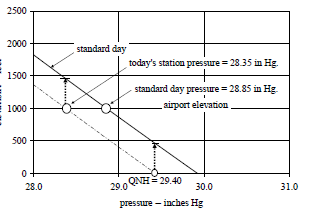I hate to bring this back up again after so much work has been done to improve
it, but I still see an important issue with it. There appears to be something
wrong with the relationship between QNH and the ambient pressure at that
location. As an example, I located the airplane at a high elevation airport
(SLLP) in La Paz, Bolivia. Using real weather the METAR indicated a QNH of
1037. The altitude simulation variables are shown in the following screenshot:
ambient pressure at the airport of 635.45 hPa for the QNH of 1037 and airport
elevation of 13,313 ft. However, for that elevation and QNH, the ambient
pressure should be 627.57 hPa. The MSFS pressure leads to a pressure altitude
of 12,355 ft, but it should really be 12,670 ft. A QNH of 1037 should shift
the pressure vs altitude curve down by 642.5 ft. If the ambient pressure is
really 635.45 hPa at the field elevation of 13,313 ft, then the QNH should be
1048.8. My calculations are based on the following equations from the Boeing
Jet Transport Performance Methods document (with 1013.25 hPa substituted for
29.92 in Hg as the sea level pressure).

 This is a stumbling block for us
This is a stumbling block for usin trying to implement the effect of barometric pressure compensation since
what we would be basing it on (the equations above) are different than what
MSFS appears to be using.

 The pressure altitude can be
The pressure altitude can be For example, plug in
For example, plug in where g sub 0 is of course the
where g sub 0 is of course the